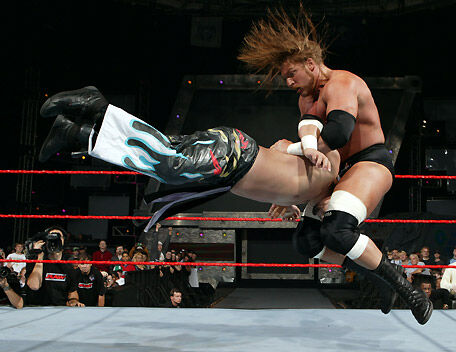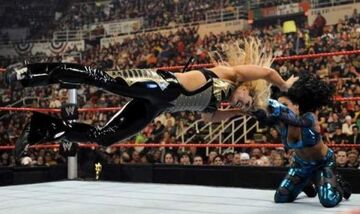A facebuster, also known as a faceplant, is generally a takedown move in wrestling in which an attacking wrestler forces his/her opponent down to the mat face-first without involving a headlock or facelock. If these are used then the move is either a DDT or bulldog variation. Inverted mat slams are commonly referred to and considered to be facebusters. A standard facebuster, also known as a jumping facebuster, involves the wrestler grabbing hold of the opponent's head / hair and jumping down to their knees, forcing the opponent's face into the mat.
Variations
Argentine facebuster
The attacking wrestler places an opponent in an Argentine backbreaker rack, where the opponent is held face-up across both the shoulders of the wrestler, from here the wrestler falls sideways (towards the side where the opponent's head is held) while still holding the opponent's head with one arm and flipping the opponent's legs over with the other, driving them down to the mat face-first.
Complete Shot
Well known as the Reverse STO, this is a move in which a wrestler stands side-to-side and slightly behind with the opponent, facing in the opposite direction, and reaches around the opponent's torso with one arm across the opponent's chest with his/her hand holding onto his/her other hand which is behind the opponent's head. The wrestler then falls backward, driving the opponent into the mat face-first. In Japan, the wrestler known as Gedo began using the move while a member of a stable of wrestlers known as the "Complete Players"; this is where the Complete Shot name derives. The wrestler can also cross his/her leg between the opponent's leg before hitting the Complete Shot, with this slight variation being known as a leg hook reverse STO.
Arm triangle facebuster
This version of a Reverse STO first sees an attacking wrestler apply a standing arm triangle choke before falling backwards to drive the opponent's head face-first to the mat. This stresses the choke which is already applied on the opponent while further damaging their arms, shoulders, and neck as well as impacting the opponent's face on the mat. The arm triangle choke is often maintained after the initial facebuster for a submission attempt.
Leaping reverse STO
A variation introduced by Judas Mesias, who called it the Straight to Hell, involves the wrestler leaping and grabbing the opponent and then driving the opponent's face into the mat.
Lifting reverse STO
A variation that is executed when the opponent is lifted off the mat then drop them into the Complete Shot.
Swinging reverse STO
The opponent is drawn forward before being thrown back and the attacking wrestler then swings them around and down to the mat.
Diving facebuster
This variation sees the wrestler grab a hold over the opponent's head/hair,then climb to the second rope and finally jump from there dropping to their knees or in a sitout position and planting the opponent face first to the mat. In another variation the wrestler could just jump from the turnbuckle grabbing the opponent's head/hair in the air and planting them to the mat.
Double underhook facebuster

The wrestler bends their opponent forward, placing the opponent's head between the wrestler's legs and then applies a double underhook on the opponent. The wrestler then jumps up while tucking their knees causing them to lift their opponent off the mat before landing on their knees, forcing the opponent's face into the mat. Triple H, the most famous user of this move, named it the Pedigree. A sitout version of this move can be used as well. It was made popular by former TNA Knockout Velvet Sky who named it the In Yo' Face.
Another variation of this move, used by CM Punk who called it the Pepsi Plunge, sees a wrestler ascend to the top turnbuckle so that they are standing on the top rope. While doing this they pull their opponent with them so that the opponent is standing on the second rope. The wrestler then applies the double underhook and jumps forwards lifting their opponent into the air before dropping to the mat, landing on their knees and driving the opponent's face into the mat with increased force.
Inverted double underhook facebuster
An attacker stands behind an opponent, overhooking both arms of the opponent and pivoting 180º so that the opponent is now looking down to the mat with the back of his/her head situated under the lower back (often with the attacker's legs partially straddling the opponent's head.) Leaving the arms underhooked behind both wrestlers, the attacking wrestler would drop to a kneeling position driving the opponent's face into the mat. This is often referred to as an Inverted Pedigree.
A variation on this sees the attacking wrestler take hold of the wrists of an opponent from behind and placing his/her head onto the upper back of the opponent. From this position the wrestler would pivot 180º so that the opponent is now looking down to the mat with the back of his/her head situated under the upper back of the attacker and his/her arms (which are still held by the wrestler) come over the shoulders of the attacking wrestler. At this point the wrestler would fall backwards driving the opponent's face into the mat below.
Lifting double underhook facebuster
This facebuster is performed when a wrestler bends an opponent forward, placing the opponent's head between the wrestler's legs (a standing head scissors), and hooks each of the opponent's arms behind his/her back. The wrestler then pulls back on the opponent's arms lifting him/her up so that the opponent is held upside down facing in the same direction as the wrestler, as in a double underhook piledriver, the wrestler then falls forward planting the opponent's body into the mat face-first.
A variation used by Michelle McCool, which she called Wings of Love; instead of falling forward, she plants the opponent face-first on to the mat in a sitout position. Christopher Daniels uses a similar sitout lifting double underhook facebuster variation, but he first spins 90º before executing the facebuster. That version is called the Angel's Wings.
Electric chair facebuster
The wrestler approaches the opponent from behind, and lifts him on his shoulders into a seated position, the electric chair. The wrestler then lifts the opponent up by his thighs and pushes him forward and down, slamming him down to the mat chest first. The wrestler may also sit down while slamming the opponent.
Forward Russian legsweep
This facebuster, best known as the Stroke as used by Jeff Jarrett, sees an attacking wrestler stand side-to-side and slightly behind an opponent (facing in the same direction) before reaching behind the opponent's back to hook the opponent's head with his/her other hand extending the opponent's near arm, then while hooking the opponent's leg with his/her own leg the wrestler falls forward, pushing the opponent forward to the mat face-first.
Full nelson facebuster
In this variation on the Forward Russian legsweep, the attacking wrestler stands behind, slightly to one side of and facing the opponent before reaching under the opponent's arms with his/her own corresponding arms and places the palms of his/her hands on the neck of the opponent, thereby forcing the arms of the opponent up into the air (as in a full nelson hold). The attacking wrestler next hooks the opponent's near leg and throws themselves forwards, driving the opponent face first into the ground.
Gory Bomb
This back to back release facebuster is a variation of the Gory special where a wrestler would release the arms of the opponent to take hold of the opponent's legs while dropping to a seated position, forcing the opponent to fall forward and impact the mat face-first.
Hangman's facebuster
Also described as an over the shoulder facebuster or an inverted snapmare into a facebuster, this facebuster is performed when an attacking wrestler, who is standing in a back-to-back position with an opponent, reaches back to pull the opponent's head over his/her shoulder before (while keeping a hold of the opponent's head) falling forwards to twist the opponent's head over so they slam face first into the mat.
Kneeling facebuster
A kneeling facebuster is used by Black Reign in which he kneels instead of falls into a seated position which he calls the Blackout. A slight variation of the kneeling facebuster sees a wrestler fall into the kneeling position while having the opponent's head between their legs and pushing the opponent down with their hands.
Push up facebuster
A variation where a wrestler puts the head of his opponent between his legs as he performs a number of push ups, causing the opponent's face to be slammed into the canvas a number of times. Often instead of straight push ups, the attacking wrestler just bounces his legs up and down to create the effect.
Reverse chokeslam facebuster
The attacking wrestler grabs hold of an opponent's neck with both hands, one on the front, and one on the back. The arm that has the hand on the back of the neck may hook the opponent's arm. The wrestler then lifts the opponent up, releases the hand holding the front of the opponent's neck, and pushes forward and slams the opponent to the mat face first with the other hand.
Sitout facebuster
Also known as a sit-down facebuster. This is the most common variation of the standard facebuster in which the attacker grabs hold of the opponent by his/her head or hair then jumps down into a sitting position, forcing the opponent's face into the mat between the attacker's legs. There is also a variation in which it appears as though the attacking wrestler is executing a powerbomb but instead pushes his or her opponent off their shoulders and grabs the opponent's head for the facebuster. This variation is often called the Facebomb.
Spinning facebuster
Also known as a spinning kneel-out facebuster or a tornado facebuster. This sees the attacker run at the opponent, grab hold of them by his/her head or hair then spins in the air before dropping down into a kneeling position, forcing the opponent's face into the mat.
Wheelbarrow facebuster
Also called a reverse powerbomb this facebuster sees the attacking wrestler grab a standing opponent around the waist from behind and lift them before then falling to a sitting position, swinging the opponent down so that their face is driven into the ground. Not all wheelbarrow facebusters see the wrestler drop to a sitting position, Vader used a variation where he remains standing while he slams the opponent to the mat. Vader called this a Face Eraser.
Feint backdrop wheelbarrow facebuster
A variation to the wheelbarrow facebuster which sees the attacking wrestler stand at the side of an opponent and begin to lift them as for a backdrop suplex. Instead of falling backwards to drop the opponent back first, the wrestler would stops after lifting the opponent, grabs a hold of his legs while still holding the opponent up, and slamming him/her face first on to the mat. Like all wheelbarrow facebusters, this can be finished with the attacking wrestler dropping to a seated position, or left standing.
Chickenwing facebuster
The wrestler hooks both an opponent's arms in a double chickenwing, lifts them up into the air from behind, then drops the opponent down onto the mat face first. There is also a sitout variation, where a wrestler drops to a seated position while planting the opponent between the wrestler's legs.
Full nelson wheelbarrow facebuster
An attacking wrestler applies a full nelson from behind and lifts an opponent before falling to a sitting position and swinging the opponent down so their face is driven into the ground.
